
Honda HR-V Review

Introduction
It is hard to believe that Honda’s HR-V has been with us since 1998.
From its boxy, square origins as a beach-going vehicle to the second-generation version, which looked like an enlarged Honda Civic, it's now back with an all-new design that looks more like a sizeable 4x4 off-roader.
Select's rating score* - 3.3 / 5
At a Glance
It is actually a family-sized SUV crossover, so don’t be fooled. It looks like a giant in the pictures, but it's not anywhere near as big as you think in the metal. In fact, the bottom half of the vehicle looks disproportionately large compared with the top half from some angles.
The front is especially imposing, with a high bonnet and mean-looking headlights. There is also a widened hexagonal grille that looks like it's been created by slicing lines out of the main bodywork rather than bolted on afterwards. A smaller lower grille creates a wide “n” shape underneath the number plate, with small day-running lights on either side.
You do get a sense of the HR-V’s (dis)proportions at the side. The windows don’t look very tall at all, certainly compared with the size of the doors, which look mainly un-sculpted, apart from at the bottom where there’s a modest crease. The roof angles down slightly towards the back, with the rear windscreen angling outwards diagonally from the top.
At the back, the Honda looks a bit fiddly. There is a strip running along the whole width of the boot lid, either side of the angular rear lights, and there’s a hefty indentation immediately beneath the strip. Another large ‘n’-shaped indentation accommodates the number plate. At the same time, a modest rear spoiler overhangs the back windows.
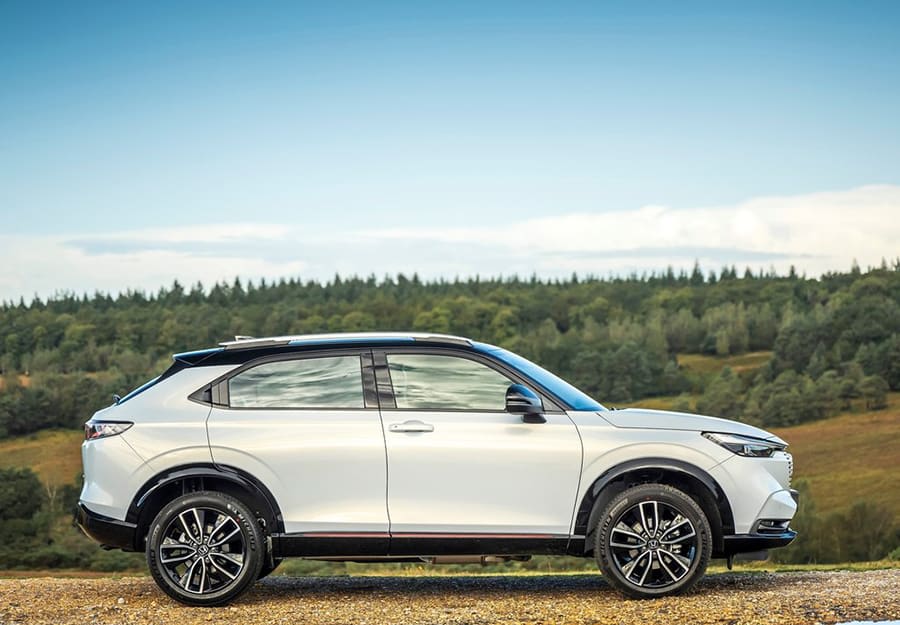
Key Features
The only powertrain available is a 1.5-litre petrol engine, which combines with two electric motors to produce a total of 131PS.
That really isn't a lot, given there are three power sources here. But then, as a self-charging hybrid, the electric motors have limited influence compared with a plug-in hybrid or an all-electric vehicle.
Mind you; the combustion unit runs on what’s called the Atkinson cycle. Far from being something Mr Bean would understand, it's essentially a more efficient type of engine that has far greater fuel economy but outputs less power. The idea is that the power deficiency is offset by the engine working in conjunction with the electric motors to share some of the workload.
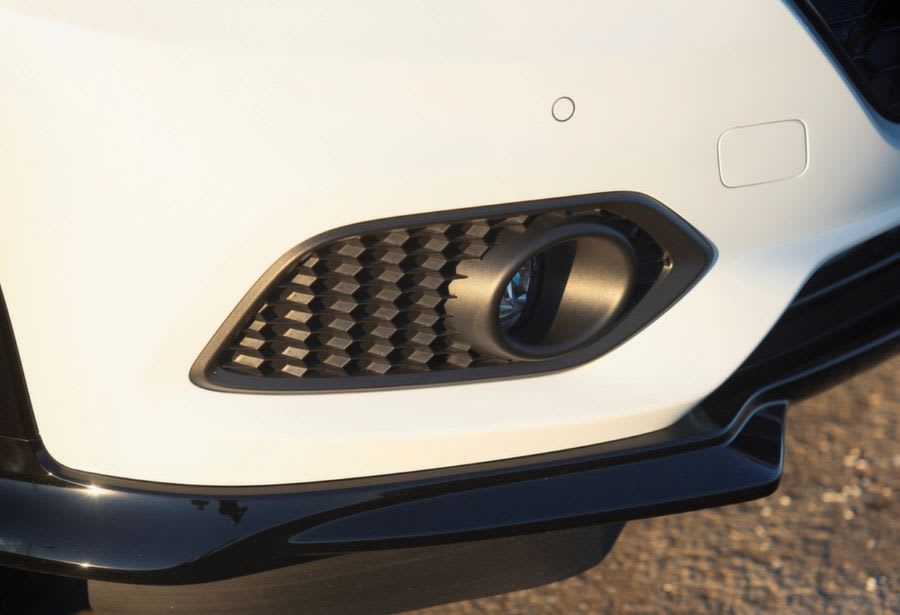
The gearbox is different, too. It is a CVT (constant variable transmission) – a single-speed transmission. The short explanation for those not familiar with CVTs is that there is only one gear. A CVT uses a belt to adjust gear ratios instead, unlike a conventional gearbox, which needs multiple different-sized cogs. This eliminates the need for lots of gears.
The Honda HR-V is front-wheel drive, and there are three trims to choose from.
Elegance features 18-inch alloy wheels, a Honda Connect nine-inch touchscreen, heated front seats and heated door mirrors. You also get keyless entry and start, parking sensors and a rear-view camera, as well as adaptive cruise control.
Advance adds an air diffusion system, a heated leather steering wheel and an automatic electronic tailgate.
The top-of-the-range Advance Style boasts roof rails, LED cornering lights, a two-tone roof and a wireless phone charger.
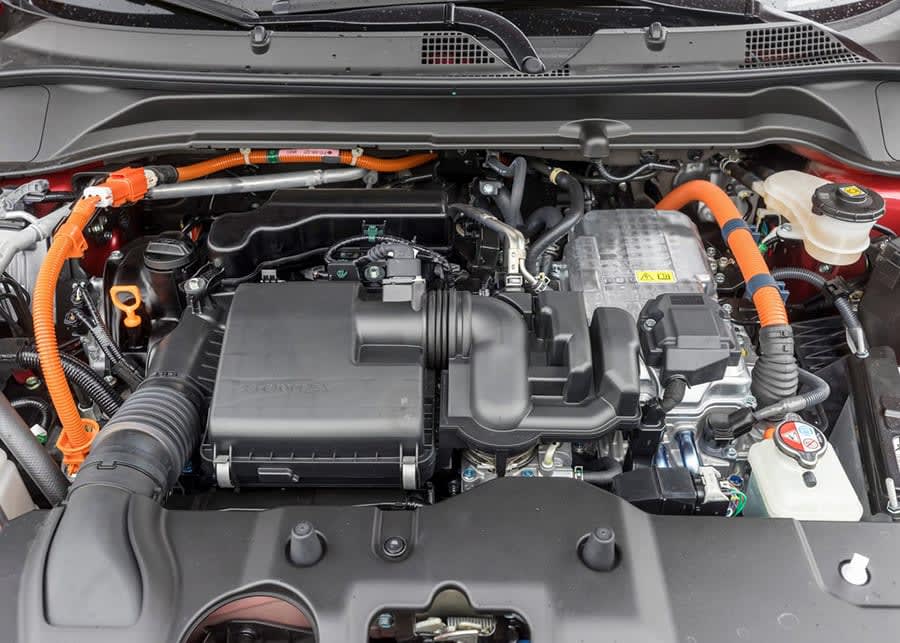
Performance & Drive
Honda’s new HR-V isn't what you'd call quick, but it's not overly sluggish either. Nought to 62mph is dealt with in 10.6-seconds, which is reasonable, if not especially quick.
When you floor it, the SUV doesn’t feel in a hurry to get going. But that’s a blessing in disguise, as the engine seems to whine incessantly due to the CVT gearbox. This CVT system sounds like a standard gearbox would if you were stuck in too low a gear and about to hit the rev limiter. It really gives you a feeling the engine is under strain until you take your foot off the accelerator and the noise dies down a bit.
Road racket is quite loud from the tyres at higher speeds, too. So it's definitely a car more suited to slower roads than motorways.
You can drive it in all-electric mode, which is on the sluggish side, but it's okay for pottering around town. The range is very limited, though. It is really intended for stop-start traffic in situations where having the engine constantly ticking over would do nothing but waste fuel. The new HR-V will switch between using the engine and utilising the all-electric mode by itself - and the switchover is seamless.
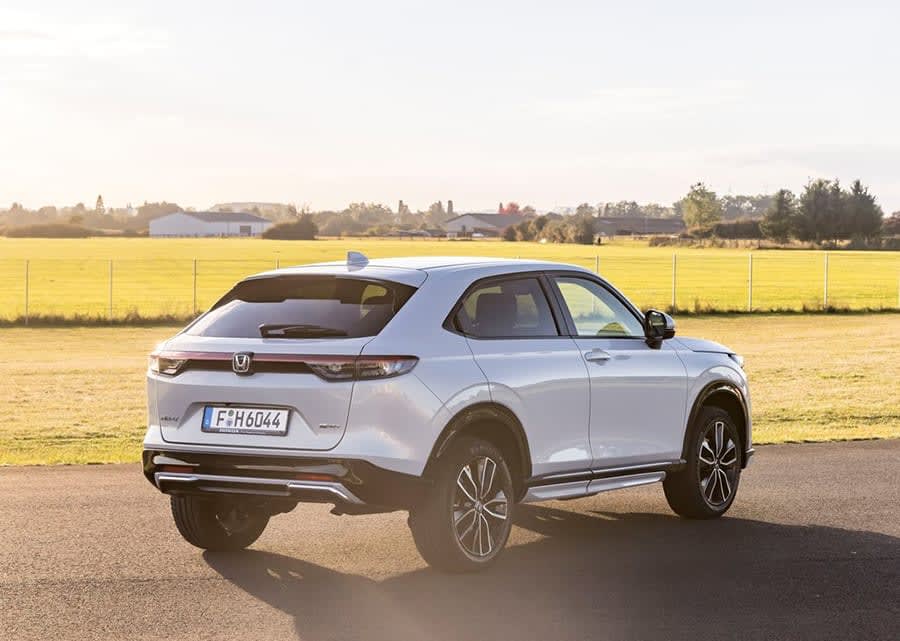
It is fairly engaging to drive, but it isn’t overly exciting. As for the handling, the latest HR-V is safe and predictable. The SUV's steering is well-weighted, and the suspension is soft, so the ride is comfortable while it smooths out most lumps and bumps in the road. Although it isn't all that nimble, the Honda feels well planted with fairly intuitive handling. Those who want a sporty driving experience will be disappointed, though.
As you’d expect, given that it’s still a hefty size, there is a bit of body lean in the corners, but it feels well-controlled and grips the road thoroughly.
When you set the regenerative braking to maximum, the HR-V recharges the batteries under deceleration, bringing you to a stop without needing to touch the brake pedal. This takes a bit of getting used to, especially as the system keeps reverting to ‘medium’ after a while.
Annoyingly, you can’t change the car’s settings while on the move, which is odd. You must be stationary.
Perhaps this is because the HR-V’s settings are in a sub-menu of the infotainment system, and Honda doesn’t want you to be fiddling with it while on the move. But, on the other hand, the Japanese automaker could have just designed it better.
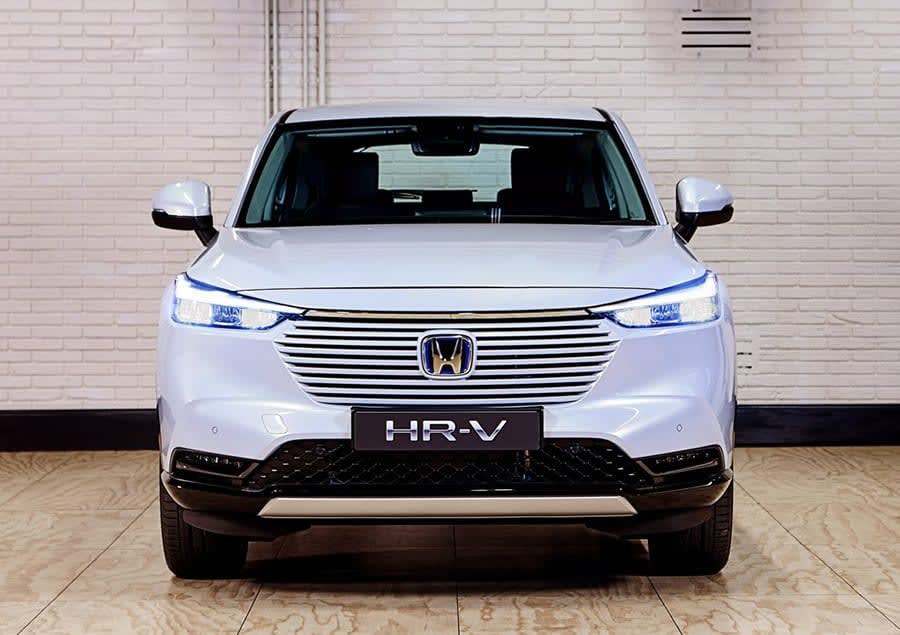
Running Costs & Emissions
The new HR-V claims fuel economy figures of 52.3mpg, emitting 122g/km of CO2. This is impressive and a key feature of the Atkinson cycle engine we mentioned earlier.
On our test route, which combined some driving around town with some twisty B-roads and a run on the dual carriageway, we averaged around 45mpg. So, Honda’s mpg figure isn’t likely to be far off what you’ll be able to expect on a long cruise.
The manufacturer has performed admirably well in recent reliability and customer satisfaction surveys. In addition, Honda clearly has faith in its products because there’s a three-year warranty up to 90,000 miles (most manufacturers restrict theirs to 60,000).
Interior & Technology
The new Honda HR-V has a good-looking interior.
Everything is laid out logically, with physical dials for the air conditioning kept underneath the infotainment screen. There are several buttons on the steering wheel and switches on the door for the electric windows, too.
You will find flashes of silver trim to break up the darkened interior shades. And, while it’s not luxurious, the car manages to achieve a decent level of attractiveness.
There are many soft-touch materials, although you will find some cheap scratchy plastics on the centre console. However, don’t fret; this doesn’t detract from the HR-V’s overall quality feel.
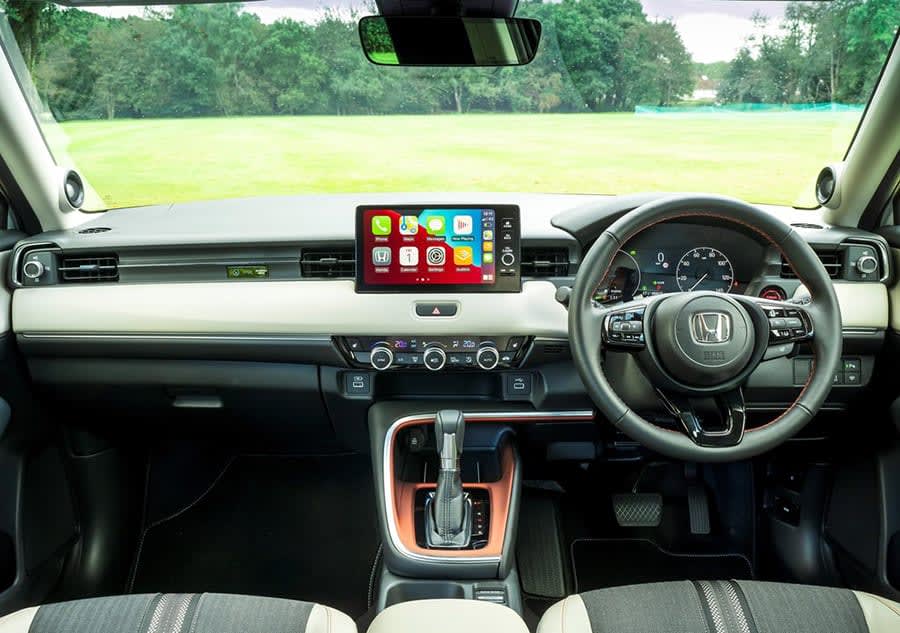
Even though the new HR-V isn’t as big as it looks in pictures, the driving position is relatively elevated, giving you that proper SUV feel. Thanks to thin windscreen pillars, there is also excellent visibility out of the front. The pillars on either side of the rear windows are thicker. But, despite this, there is still a decent view out of the back – although the parking sensors undoubtedly help when it comes to reversing.
The HR-V’s steering wheel is chunky, but getting it into a good position that’s comfortable for the driver isn’t easy, especially if you prefer to sit higher up.
The infotainment system rests on the dashboard like a tablet. It looks smart, but the screen isn’t as clear as it could be as the resolution is a bit low. It also lags a bit and isn’t intuitive to use. It is not a bad system by any means, though, and it includes wireless Apple CarPlay and wired Android Auto. It can also create a WiFi hotspot in the car for passengers to connect to, while the downloadable Honda app on your phone can act as a digital key to unlock it.
A seven-inch digital instrument display is also included. This adds a lot of clarity and is informative. But, again, a low resolution means the graphics could be clearer than they are.
The air vents inside the cabin are L-shaped. This helps air circulate more efficiently around the interior. Although it sounds gimmicky, it does seem to work.
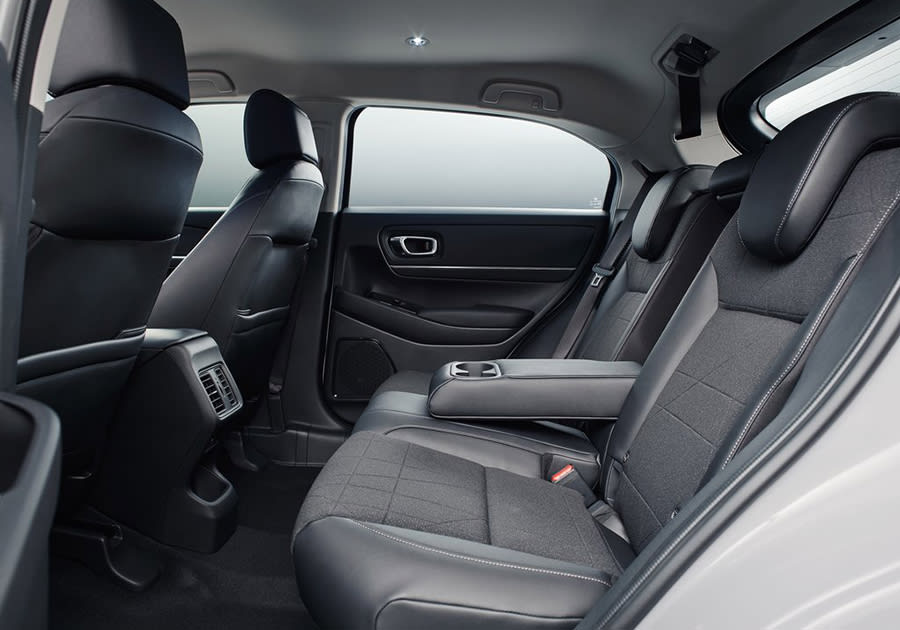
Practicality & Boot Space
The new HR-V’s seats are comfortable, with a decent amount of legroom in all seats.
Headroom isn’t a problem in the front, but, in the back, you'll find it disappointing if you're around six feet tall or more. The roofline slopes downwards a little, which means you’ll be resting your head against the roof if you sit back in the seat. This isn’t helped by the middle seatbelt being mounted on the ceiling, so it’s easy to catch your head on it if you’re not careful.
The middle seat is especially problematic. Why? Well, it’s so cushioned that it’s noticeably higher than the other two seats, reducing the headroom further.
One good thing is Honda’s ‘magic seats’ (yes, they’re actually called that). You can completely lift the rear chairs individually to fit bulky items behind the driver’s seat. Or you can fold them flat to effectively extend the boot floor into the cabin.
There isn't much storage space inside the new HR-V either. The door bins are tiny, although there’s just enough room to put a bottle upright in the front. But, alas, there are no door bins at all in the back.
Elsewhere, there is a small cubby under the centre console, two cupholders just in front of it and additional small storage space between the gear lever and the dashboard. Mind you that will be taken up by a wireless phone charger in the top-of-the-range Advance Style trim.
The new HR-V’s boot is 319-litres, expanding to 1,305-litres with the rear seats down.
If you have an upgraded sound system, this reduces the HR-V’s cargo capacity to 304-litres. This is because extra speakers are placed in the corners of the boot behind the taillights.
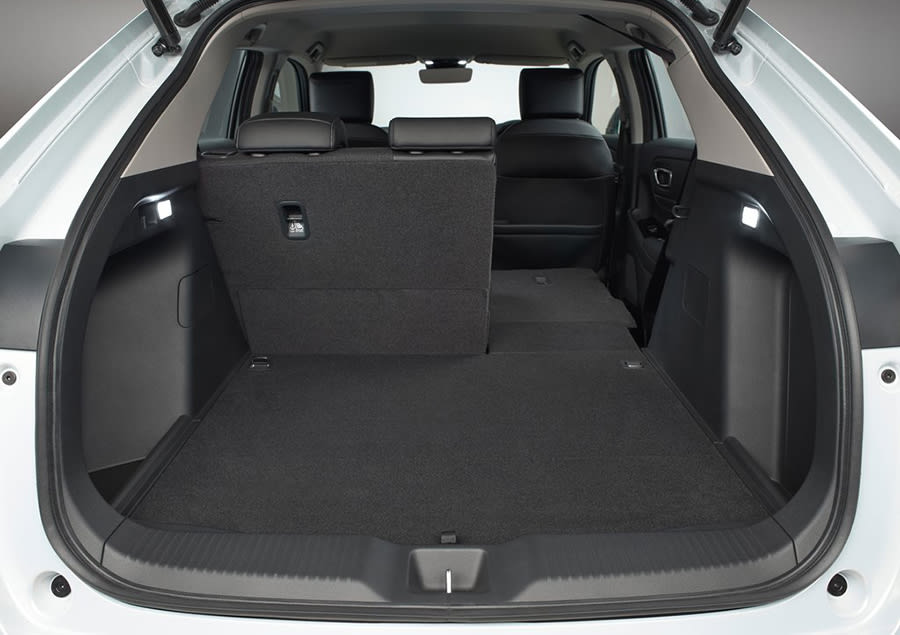
Safety
Crash test organisation Euro NCAP hasn't assessed the new HR-V, but that shouldn’t put you off. Honda generally has a good reputation for safety standards, plus more recent models have even more safety kit in them.
Smaller cars often tend to perform less well, but even Honda’s small hatchback, the Jazz, managed to get a five-star rating in 2020. The vehicle scored 87 per cent for adult occupants, 83 per cent for children and 76 per cent for safety assists.
The old HR-V was tested back in 2015 and earned a five-star rating, too. That is not an accurate comparison, though, as the new test is very different. Euro NCAP made its criteria more stringent in 2020, so it wouldn't necessarily get five stars if re-examined today.
Nevertheless, there are plenty of safety features to reassure you. Regardless of trim, all HR-Vs features blind-spot monitoring, lane-keep assist, a collision-avoidance system and adaptive cruise control.
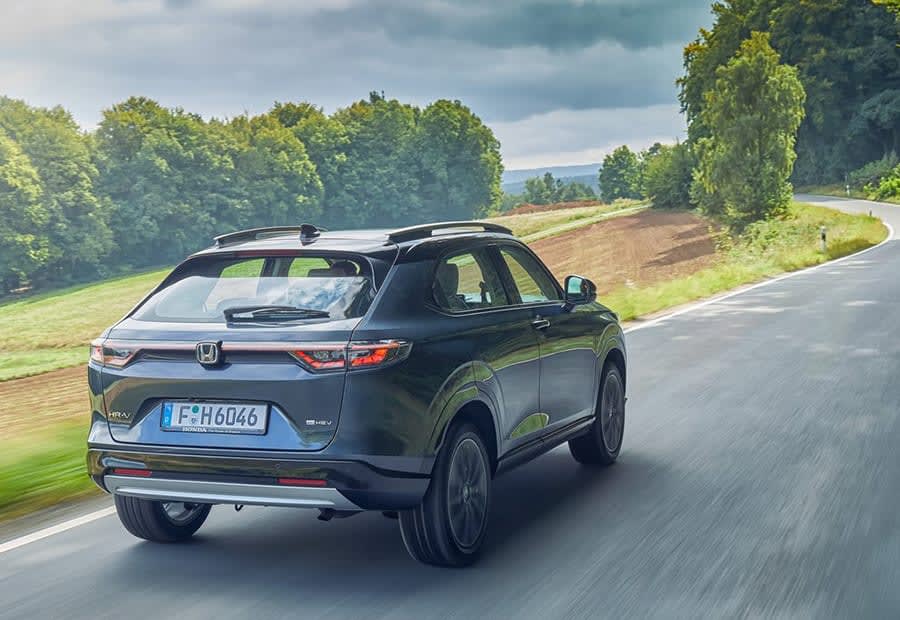
Options
The options are available in the form of three different packs.
The interestingly named Ilmenite Titanium Exterior Pack includes a tailgate decoration, a fog light decoration and a set of door mirror covers.
The similarly-named-but-actually-different Ilmenite Titanium Pack adds the same. But it also throws in decorations for the steering wheel, gear lever and a set of door switch panels.
Alternatively, the Obscura Black Pack gives the car a sportier front grille, a front lower spoiler, a modified rear bumper, and a bigger tailgate spoiler. You also get the same decorations as the Ilmenite Titanium Pack.
Finally, if you feel flush, the Sport Pack – costing four figures – gives your HR-Van even more stylish look with colour and chrome accessories. You also get a front sport bumper, a front grille, sporty beautifications for the rear and side, plus the larger tailgate spoiler.
Alternative all-black 18-inch alloys are available for a bit of extra money, while you’ll need to have deeper pockets for the same design with a diamond-cut finish.
In terms of body colour, Sand Khaki (which looks like a sort of greyish-brown colour) is provided by default. But you’ll have to pay if you want white or black pearl or ‘meteoroid grey’. It costs more still for sunlight white pearl or crystal red metallic paint.
To be honest, being asked to pay extra to have a colour that isn’t ‘greyish-brown’ isn't incredibly inspiring.
Rival Cars
There is no shortage of alternatives when it comes to small crossover SUVs. In fact, it’s a very crowded market in the UK these days.
You will want to look in the direction of the Nissan Qashqai, the Hyundai Tuscon, a Toyota CH-R, the Volkswagen T-Roc, the Seat Ateca, or the Skoda Karoq.
Alternatively, if you don’t mind something on the smaller side, a Ford Puma might suffice.
At a glance, the latest Honda HR-V may seem as though it’s more expensive. But it's pretty evenly matched compared with most rivals in terms of the hybrid versions that are offered.
If you go for a cheaper competitor, it’s unlikely to be a hybrid, nor will it come with so much kit as standard.
If you decide Honda’s new HR-V isn’t classy enough for you, none of the above alternatives is likely to satisfy you either. So, you’ll be looking towards more premium vehicles such as the Volvo XC40, the new Volvo C40 (which is basically the same as the XC40 but with a coupe-styled roof) or a BMW X1, especially if you want a better interior.
Verdict & Next Steps
The new Honda HR-V is a good all-rounder – unassuming and grown-up, if a little on the bland side. It is okay. Satisfactory. Adequate. But not really anything special.
To drive, it’s more of an A to B car than something that you’d lease for the driving experience. But it has reasonably decent handling and is sufficiently comfortable. Albeit, it’s far better suited to shorter low-speed journeys where you can make the most of its ability to run on electric juice only.
On the plus side, the new HR-V has got plenty of space inside (as long as you’re not a tall passenger in the back), it’s well equipped, the interior is nice, while the Honda is quiet at low speeds and superbly economical for a petrol.
But the boot space is limited, the rear headroom is an issue for adults, it's not very powerful, and the engine can scream.
Overall, if your expectations aren’t too high, the Honda HR-V will tick plenty of boxes. But there are better motors available for the same amount of money.
Where to next?
View latest Honda HR-V leasing deals- guide price from £326.73 per month inc VAT**
Looking for a great leasing deal? Check out our incredible range of car lease deals
New Hatchback? Read our latest Reviews and find the right model for you
Want to know more about leasing? Take a look at our comprehensive Leasing Guides
Interested in everything motoring? Why not catch up on all the latest Car Leasing News.
*Score based on Select’s unique meta score analysis, taking into account the UK’s top five leading independent car website reviews of the Honda HR-V
**Correct as of 18/01/2022. Based on 9 months initial payment, 5,000 miles over a 48 month lease. Initial payment equivalent to 9 monthly payments or £2940.57Ts and Cs apply. Credit is subject to status.





















